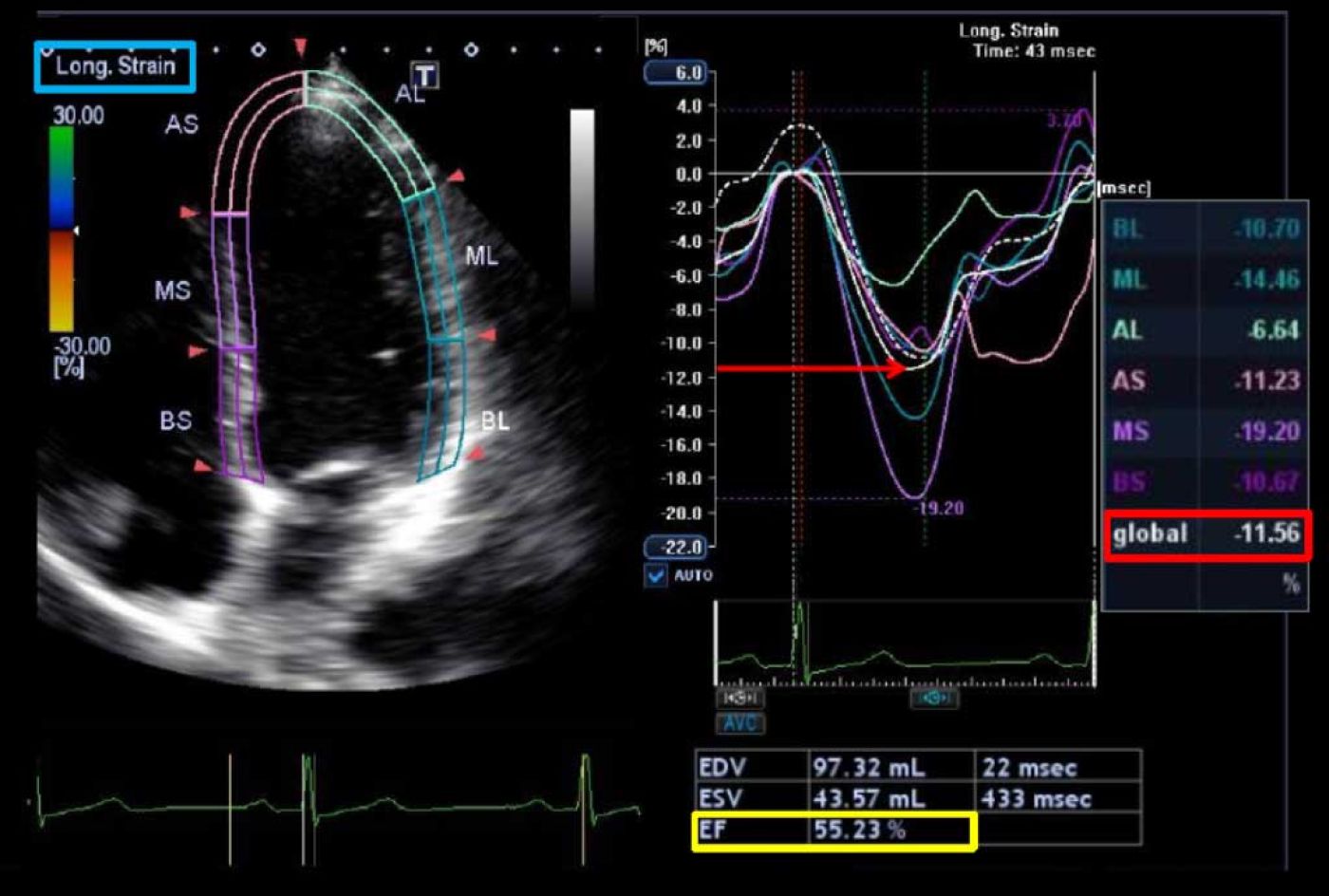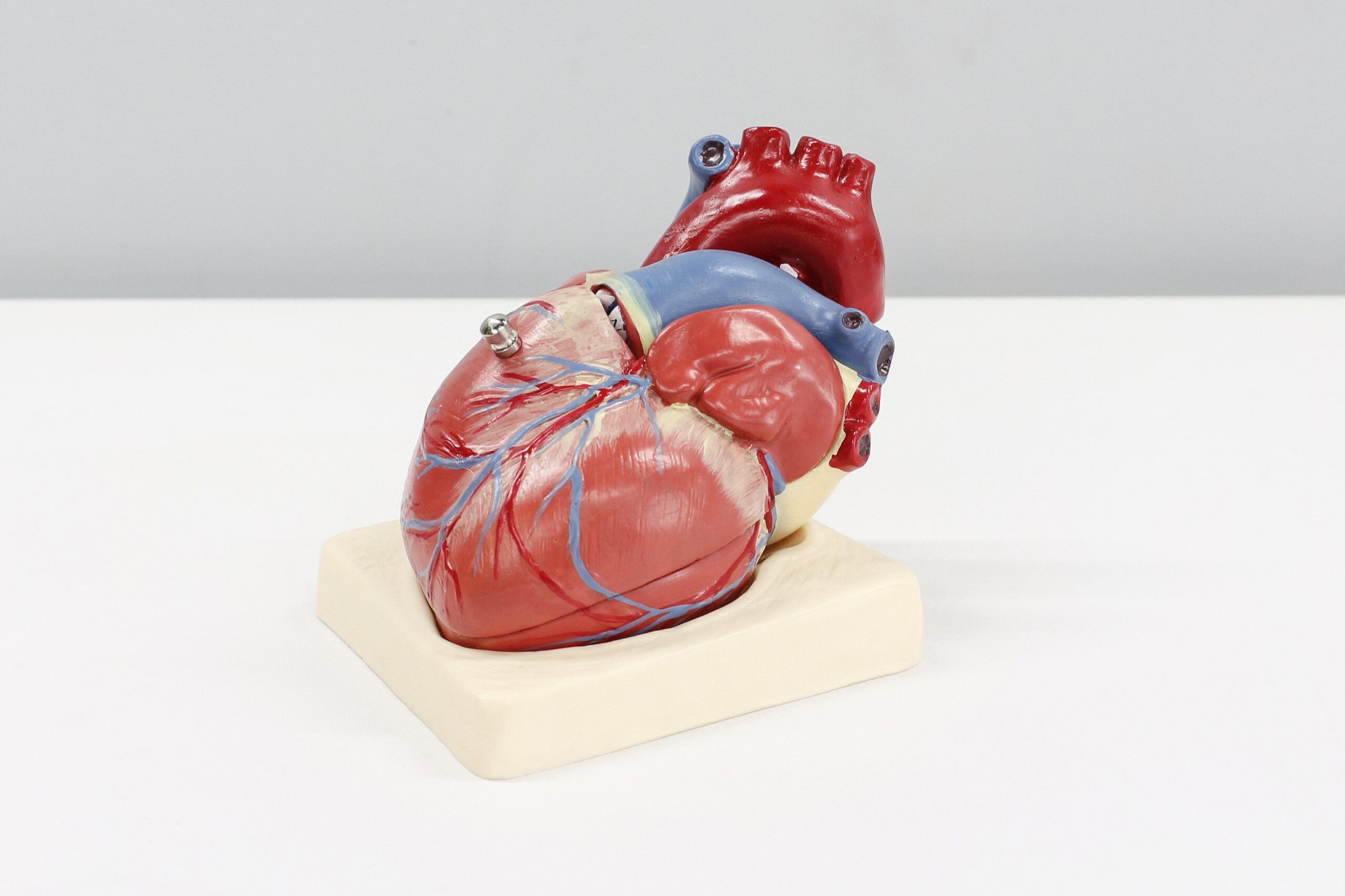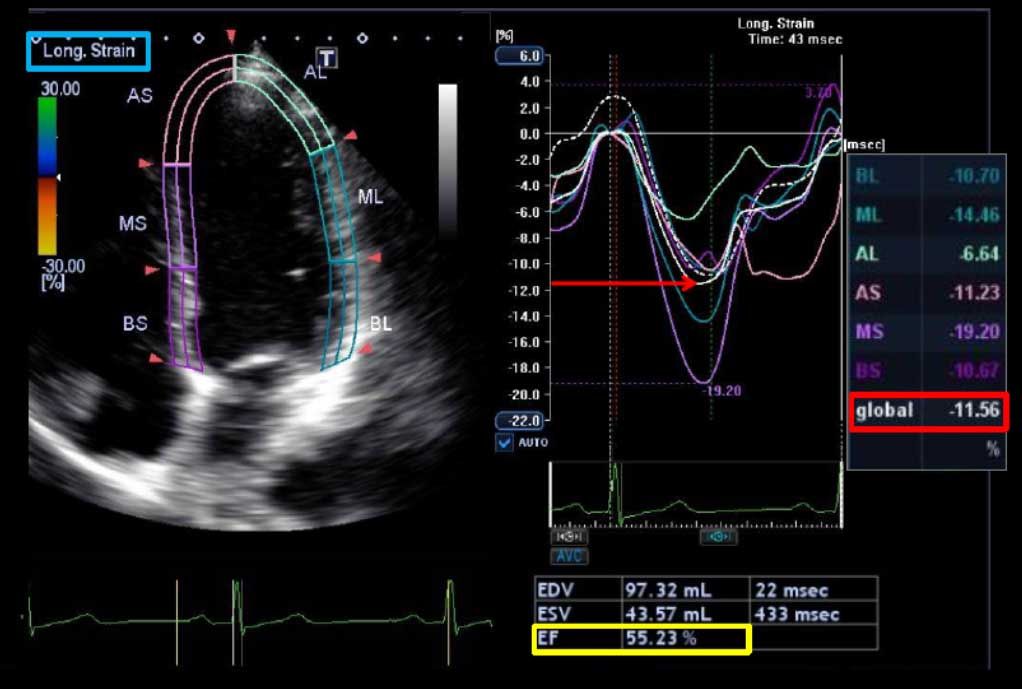Myocardial Strain Imaging by Echocardiography for the Early Detection of Chemotherapy-induced Cardiotoxicity

The mortality rate among patients with cancer has decreased over the past 20 to 30 years. However, cardiac toxicity (cardiotoxicity) from cancer therapy has become a leading cause of morbidity and mortality in survivors. In patients who develop heart failure (HF) from cancer therapy, the mortality rate is as high as 60% by 2 years. Therefore, contemporary management of patients with cancer should include careful consideration of potential cardiotoxicity during therapy, with a focus on early detection and intervention.
Several definitions of cardiotoxicity have been proposed. The most commonly used definition is a ≥ 5% reduction in symptomatic patients (or ≥10% reduction in asymptomatic patients) in the left ventricular ejection fraction (LVEF) from baseline to an LVEF < 55%. Early detection of cardiotoxicity has predominantly relied upon serial cardiac imaging to identify a reduction in left ventricular (LV) function without signs or symptoms of heart failure (stage B HF).
The use of LVEF has important limitations. First, the measurement of LVEF is subject to technique-related variability, which can be higher than the thresholds used to define cardiotoxicity. Second, the reduction in LVEF is often a late phenomenon, with failure to recover systolic function in up to 58% of patients despite intervention. Hence, there has been a growing interest in markers of early myocardial changes (i.e., changes with normal LVEF) that may predict the development of subsequent LVEF reduction or the progression to HF, so that preventive strategies with established cardioprotective medications such as beta-blockers, angiotensin-converting enzyme inhibitors, or dexrazoxane could be implemented.
All studies of early myocardial changes with chemotherapy demonstrate that alterations of myocardial deformation precede significant change in left ventricular ejection fraction (LVEF). Using tissue Doppler-based strain imaging, peak systolic longitudinal strain rate has most consistently detected early myocardial changes during therapy, whereas with speckle tracking echocardiography (STE), peak systolic global longitudinal strain (GLS) appears to be the best measure. A 10% to 15% early reduction in GLS by STE during therapy appears to be the most useful parameter for the prediction of cardiotoxicity, defined as a drop in LVEF or heart failure.
A systemic review published in July 2014 in the American Journal of Cardiology (JACC), by P. Thavendiranathan et al., confirms the value of echocardiographic myocardial deformation (strain imaging) parameters for the early detection of myocardial changes and prediction of cardiotoxicity in patients receiving cancer therapy.
These results can be summarized into the following key points:
- Cardiotoxicity from cancer therapy is a leading cause of morbidity and mortality in cancer survivors, and is most typically defined as a decrease in left ventricular ejection fraction (LVEF) by ≥ 5% or ≥ 10% for symptomatic and asymptomatic patients, respectively. As early identification may alter management and attenuate cardiotoxicity, there is a need for early markers of cardiotoxicity before a significant change in EF occurs.
- Echocardiographic assessment of LVEF or diastolic function does not appear to be able to identify cardiotoxicity at an early subclinical phase.
- Existing studies consistently identify that changes in myocardial deformation happen earlier than changes in LVEF. Using two-dimensional strain imaging, global longitudinal strain is more reproducible than other measures of strain such as global radial strain or global circumferential strain. Using tissue Doppler-based imaging, longitudinal strain rate appears to be a consistent marker of changes in myocardial deformation, while other measures appear to be less reliable.
- On a review of the literature examining the prognostic value of strain imaging in chemotherapy patients, an early decrease of 10-11% (95% confidence interval, 8-15%) in global longitudinal strain predicts cardiotoxicity. Other individual markers have not been predictive, although combined use of global longitudinal strain and LV twist may be a better predictor than the former variable alone.
- Late cardiotoxicity can be observed several years after chemotherapy is completed. While there are multiple studies examining myocardial deformation during a longer-term follow-up after treatment, the relationship of abnormal findings and prognosis remains uncertain.
- Radiotherapy may also be associated with early changes of the myocardium, and some literature has observed a change in myocardial deformation immediately following treatment, although separating the effects from radiotherapy and chemotherapy is difficult, as they are often used simultaneously.
- Current recommendations for cardiac evaluation of patients prior to cancer treatment are variable and not specific. While multiple modalities can be used, echocardiography has advantages given its versatility, low cost, and excellent safety profile.
- While normal ranges for global longitudinal strain from a recent meta-analysis suggest a normal cutoff of -19% to -22%, there is significant between-patient variability, suggesting that within-patient changes in strain may be more reliable than population-based thresholds.
- While strain imaging is a promising method to identify early cardiotoxicity, further multicenter study is needed that includes cancers other than breast cancer, and compares management and outcomes between patients initiated on cardioprotective therapy on the basis of strain imaging versus traditional measures such as LVEF.
Source:
Thavendiranathan P, Poulin F, Lim KD, Plan JC, Woo A, Marwick TH. Use of Myocardial Strain Imaging by Echocardiography for the Early Detection of Cardiotoxicity in Patients During and After Cancer Chemotherapy – A Systematic Review J Am Coll Cardiol. 2014;63(25_PA):2751-2768. doi:10.1016/j.jacc.2014.01.073
LaBounty TM (Cardiosource).


